Exploring The Solent Shore - Hill Head To Meon Shore
By Mike on Sunday, June 9, 2013, 21:50 - Permalink
 A beautifully sunny Sunday afternoon, so we decided to do a little coastal foraging and beachcombing from Hill Head along to Meon Shore.
A beautifully sunny Sunday afternoon, so we decided to do a little coastal foraging and beachcombing from Hill Head along to Meon Shore.
This is the fourth in a series of articles, exploring the Solent shoreline and immediately adjacent lands.
The Route
We started from Salterns Park, walking northwest along the beach to Hill Head Harbour, From there, a little further northwest along the sea wall to Meon Shore, then back the same way. Not a very long walk - maybe a two mile round trip, but this is an interesting little section of coast.
Setting Off
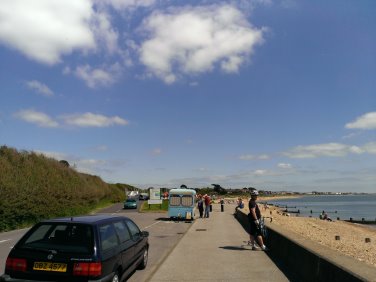 Parking at Salterns Park is free, and there's a pleasant promenade walk to the east that leads all the way to Lee-on-the-Solent (but we're not going that way today).
Parking at Salterns Park is free, and there's a pleasant promenade walk to the east that leads all the way to Lee-on-the-Solent (but we're not going that way today).
An ice cream van in the car park offered the promise of a refreshing reward at the end of our walk, on this baking hot sunny day.
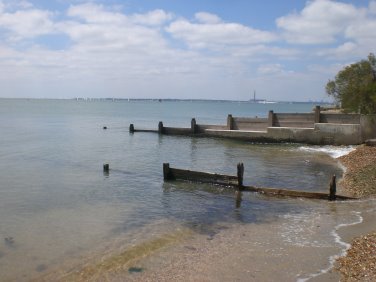 Like most other parts of the Solent shore, this beach is composed of a mix of flint shingle, grit and sand - and the whole area is prone to longshore drift (the tendency for beach aggregates to be transported along the beach in one direction, propelled by tide and the prevailing angle of incoming waves).
Like most other parts of the Solent shore, this beach is composed of a mix of flint shingle, grit and sand - and the whole area is prone to longshore drift (the tendency for beach aggregates to be transported along the beach in one direction, propelled by tide and the prevailing angle of incoming waves).
At the supply end of a longshore drift, new material is usually added by eroding cliffs, but of course, humans may find coastal erosion a problem - so timber groynes are a common feature - these slow down the process of longshore drift by trapping gravel and sand.
This often means that the ground level on one side of a groyne may be considerably higher or lower than the other - so it's wise not to just hop over them without looking.
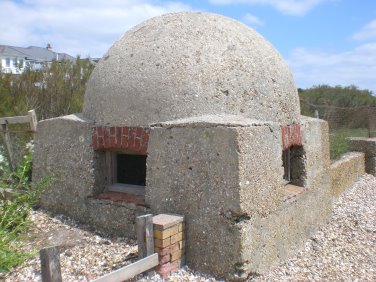 A little way west from Salterns Park, there is an interesting pair of concrete structures at the top of the beach.
A little way west from Salterns Park, there is an interesting pair of concrete structures at the top of the beach.
I've not managed to find any definitive information on these buildings, but it seems highly likely they must be military/defensive - perhaps sentry or lookout bunkers from WWII.
However, it's also possible that they might have been icehouses - if anyone knows more about them, please do let me know.
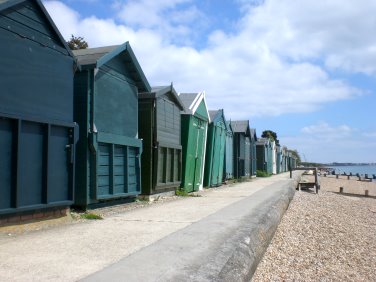 Further on, there's an orderly row of beach huts - The huts themselves are privately owned, but people rent the site from the local council (this is not cheap), then fit them out for day trips - some have basic catering or dining facilities, others are used primarily to store beach chairs, inflatables, or anything else you might need for a fun day at the beach.
Further on, there's an orderly row of beach huts - The huts themselves are privately owned, but people rent the site from the local council (this is not cheap), then fit them out for day trips - some have basic catering or dining facilities, others are used primarily to store beach chairs, inflatables, or anything else you might need for a fun day at the beach.
Beach huts in the UK are a tradition dating back to Victorian times, but are still enormously popular today. Waiting lists several years long to acquire one are not uncommon, and in some locations, they change hands for absurdly high prices - in excess of the price of a family home inland.
Hill Head Harbour
Hill Head harbour is a tiny, quiet little haven for pleasure and fishing boats and is the home of a local sailing club. It's popular with sea anglers and children dipping for shore crabs. Swans, ducks and other waterfowl are often found here.
Hill Head harbour is actually the mouth of the river Meon - a system of sluice gates maintains the water level upstream - so the harbour is really the only tidal part of the Meon.
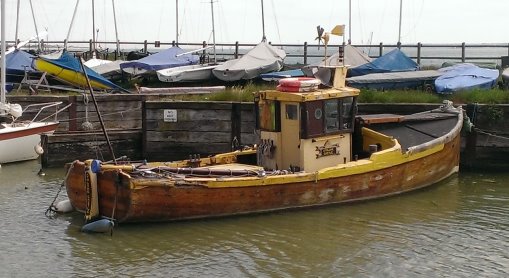
Tichfield Haven
 Across the road from the harbour is Tichfield Haven Nature Reserve - an area of coastal wetland alongside the lower reaches of the river Meon.
Across the road from the harbour is Tichfield Haven Nature Reserve - an area of coastal wetland alongside the lower reaches of the river Meon.
Although quite small, this is a hugely important nature reserve with enormous biodiversity - for example, over 200 species of birds have been recorded here.
The reserve has a visitor centre, gift shop and cafeteria. Admission to the reserve is reasonably priced and inside there is a network of walkways and hides for observing the wildlife.
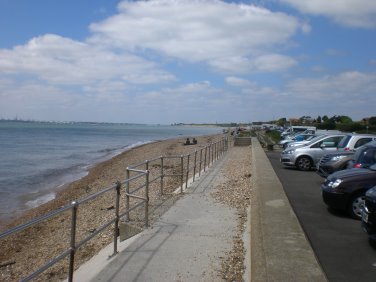 From the harbour and haven, there's a curved sea wall (a popular location for fishing) leading round to Meon Shore.
From the harbour and haven, there's a curved sea wall (a popular location for fishing) leading round to Meon Shore.
Heading Back
 On the way back, we enjoyed watching the brightly coloured sails of a group of small sailing dinghies - actually a sailing lesson for kids.
On the way back, we enjoyed watching the brightly coloured sails of a group of small sailing dinghies - actually a sailing lesson for kids.
Fossils
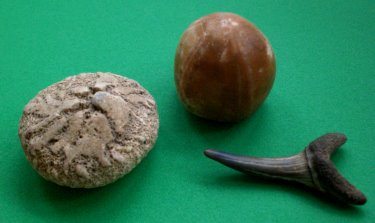
This stretch of coast is a good location for fossils - indeed, the flint pebbles of which the beach is composed are in fact the fossil remains of the silicate skeletons of sponges, corals and other marine invertebrates.
I found these three specimens on a previous trip to the beach on the first stretch of this walk - they are (left to right): a sponge, a (worn, but still recognisable - note the vertical striations) sea urchin and a shark tooth.
All of these were discovered just by sitting and sifting/digging through the beach shingle by hand for an hour or so.
Witch's Hat
 On return to the car, we were in great need to refreshment - it was only a shortish walk, but it was a scorching hot day and I felt parched.
On return to the car, we were in great need to refreshment - it was only a shortish walk, but it was a scorching hot day and I felt parched.
So the ice cream van was a welcome sight - and I treated myself to a Witch's Hat - this is an ice cream configuration many of my work colleagues have known and loved all their lives, but I never knew about until quite recently.
It comprises a wafer cone topped with a scoop of ice cream, with a rocket ice lolly inserted upside down in the top. When held with the lolly right-side up, the cone resembles a pointed hat, hence the name.
It's a delicious combination and it always seems to be priced very reasonably, considering it's actually two things, but it's tricky to eat - something usually starts dripping before you're even halfway through eating it.
Foraging Opportunities
 There are nearly always good foraging opportunities at the coast - and this trip was no exception - the sea beet was absolutely at the peak of condition for picking.
There are nearly always good foraging opportunities at the coast - and this trip was no exception - the sea beet was absolutely at the peak of condition for picking.
